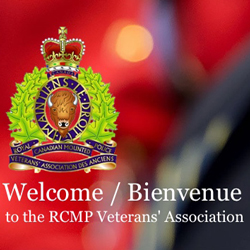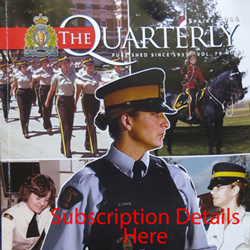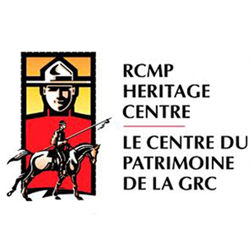A Story to be Told!
The Cartoonist Who Became the Commanding Officer of “E” Division
When I began doing stories for the Vancouver Division website it always amazed me how one person’s story connects him or her to another person or event. In reality this should not surprise me as I have found when you meet a serving member or veteran you are usually two people away from having known, worked with or heard of a mutual acquaintance. So, bear with me as this story expands.
“Regimental Number 11764 decided to publish Regimental Number 11745’s cartoons, notes and anecdotes to celebrate the one hundredth anniversary of the finest body of men in the world.” “With recent criticism and an apparently organized attack on one of our last Canadian traditions, it seems fitting to show the Service, the last one remaining, as it sees itself – its humour, inside jokes and the building of a tradition most Canadians would like to cherish.”
In 1972 in view of the next years 100th anniversary of the RCMP Frank Spalding, Reg # 11745/O.366, decided to publish a book of the cartoons he had drawn over the course of his career depicting life as he saw it in the RCMP. Finding a publisher was not hard. In the foreword of Frank’s book, it is stated:
No name is associated to the foreword, only his Regimental #.
Who is Regimental # 11764, the man who published Frank Spalding’s book? Gray Alexander Campbell carried that Regimental # for seven years. Later in life he created “Gray’s Publishing”, Sidney, BC. More later about Gray Campbell.
So, who was this cartoonist who became the Commanding Officer of “E” Division?

Regimental # 11745/O.366
Frank Spurr Spalding joined as a Special Constable, in 1921, later converting to a Regular Member and later as a Commissioned Officer (O.366).
Frank served across the Force, “C”, “J”, “F”, “D”, “F”, “K”, “A” “HQs”, “E”, “H” and finally as the Commanding Officer of “E” Division. His last day on the job was in March of 1968. He passed away in March of 1993 at Victoria, B.C.
A memorable moment, amongst many, in his career: Frank Spalding was involved in the Saskatoon Riots in 1933 and was one of the members who tried to box in Inspector Lorne Sampson’s (Reg # 6252/O.281, Honour Roll # 54) horse (“Nick”) as he fell after being hit with a rock and being dragged with his foot stuck in the horse’s stirrup. Robert Knuckle’s book, “In the Line of Duty – The Honour Roll of the RCMP” recorded the event this way:“Cst. Frank Spalding and Cpl. Pat Cleary tried to box in the runaway, but he was too fast for their horses. As “Nick” veered wildly about, he tried to run between the row of iron posts that lined the driveway. Insp. Sampson’s body swung out in an arc and his head hit one of the posts with such impact that the stirrup strap broke and Insp. Sampson’s limp body fell to the ground. He was placed in an automobile and taken to the hospital in Saskatoon where he died several hours later.” Ironically, before the troop was deployed Insp. Sampson went down the ranks and noticed a young constable was to ride a notoriously difficult horse named “Nick”. To protect the recruit, the Inspector instructed the constable to exchange horses with him. Although, the constable protested he could handle “Nick”, the Inspector insisted and the made the switch.

Below: Assistant Commissioner Frank Spalding oversees the disbandment of the Reserve Constable Program in “E” Division.

For more of the Reserve Constable Program see:
I found it interesting that Frank Spalding’s second given name was “Spurr”. In view of his father being a member of the Force, I wondered if giving his son the name “Spurr” was this a hidden message that down the road his son would follow him in his boots and spurs? Digging deeper it was nothing quite so nefarious. Frank’s mother’s maiden name was “Spurr”.
Frank Spalding’s collection of cartoons are contained in his book called “100 Years in the R.C.M.P Saddle! Or, Stop the Musical Ride, I want off!” He clearly started his flare forcartooning early in his career and continued on with his cartoonist’s view of the Force. I wonder if he ever got in trouble for his efforts? Whether those on high looked on them unfavourably?
Frank Spalding’s opening comments to his book reflect his quandary as a serving officer and his desire to continue his cartoonist’s view of the Force:
“In spite of increased responsibilities as an officer, a few cartoons still appeared from my pen, albeit not so prolifically as in the past, due in part to mounds of paperwork and the rather austere environment of the officer hierarchy.”

Below are a couple samples of Spalding’s cartoons. Each cartoon in the book has on the opposite page a story related to the cartoon and where required a commentary from the characters in the cartoon.

One of Frank’s first cartoons depicting life in the original “C” Block: “These old barracks were cold and draughty, and when blizzard conditions prevailed, the fine powered snow would blow in around the windows and form tiny drifts on the sills and floor. In the hot dry summers of the “Dirty Thirties”, instead of powered snow it was fine dust.”
“In spite of the discomfort and sometimes crowded conditions, it was a man’s world. I can still smell the saddle soap, the boot polish and leather but above all, the pervading clean odour of horse”.
The two cartoons below follow a sequence of events. Frank, then a Corporal, was part of a ceremonial parade at “Depot”. Many troops practising to make everything perfect, except for the officers. At the last minute the officers who were to be on parade were brought in brandishing their swords. Having just come from their administrative duties and not used a sword in awhile, if ever, they were called upon to practise their swordsmanship in front of the troops on parade. It did not go well for the officers. Much to the delight of the troops on parade. Frank, that night, created a cartoon to share with his troop mates. The words in the balloons above the officers were changed for the book, the original cartoon was a little more spicy
The next morning preparing to leave for home he was ordered to see the Sergeant Major. Confronted with his cartoon, it had been shared around the barracks by his troop mates, he was placed under open arrest. He was paraded before an officer, who was depicted in the cartoon, verbally chastised and ordered to appear before he C.O. in Orderly Room the next day.

Frank, standing outside the “supreme commander’s door” in red serge, breeches and boots, minus his spurs, Stetson and Sam Browne is marched into the C.O.’s office by the Sergeant Major…. “Mark Time – Halt!”
The C.O. glanced at the offending cartoon and smiled momentarily and then turned on his officer’s cold, stern face. “He did not read out the charge, nor ask me to plead to it.”
“You have a good record thus far, Spalding. Don’t spoil it. I’m familiar your flair for drawings and your sense of humour, however misdirected in this case. As for the charge of insubordination, I do not intend to adhere to the letter of the law. But your choice of subject, time and place was unwise; such action is not in the best interest of police discipline, nor your own. Remember, the pen is not only mightier than the sword, it can frequently be more dangerous. Go and sin no more! (or words to that effect). The Assistant Commissioner then dismissed the charge.”

Having a bit of a flair for cartooning over my career I can relate to Frank Spalding’s appearance in Orderly Room. I did a cartoon that came to the attention of a former Commanding Officer of “K” Division, I was removed from certain duties and ordered to be “psychologically” assessed by a Staffing Officer and a follow-up investigation by another senior officer. They must have read Frank’s book because their advise to me in the end was almost the same as the “Depot” C.O’s advise to Frank, “Don’t do it again!” But that is a story for another time.
Frank Spalding’s stories and cartoons clearly relate to a different time in the Force. Many veterans will be able to relate, newer and younger members of todays RCMP, will say “really, that happened?”
Frank Spalding’s father, James Wilson Spalding, did not have a too shabby career in the NWMP/RNWMP/RCMP. It was one of those remarkable careers rising through the ranks from constable to Deputy Commissioner. Some of his early adventures are the stuff Americans make movies about.

Born in Bathurst Township on February 27, 1878, the son of Francis Spaulding (1831-1906) and Margaret Weir (1835-1929). He joined the North West Mounted Police at Regina, Northwest Territories (Saskatchewan) on April 23, 1900, and issued Reg # 3667.
He first served with ‘F’ Division (Divisional HQ, Saskatchewan), and then, from 1905 to 1907, was assigned to the Peace-Yukon Trail Project. In 1897 and again in 1905-1907, small groups of Northwest Mounted Police (NWMP), guided by local First Nation people, undertook the task of finding and constructing a wagon trail, over 1,200 kilometers, through some of the most difficult terrain in Canada, from Fort St. John, in what is now the Peace River District of British Columbia, to Teslin Lake in the Yukon gold-fields. The objectives of the trail were two-fold; to connect the Yukon Territory with other parts of Canada, and thus secure an all-Canadian Route to the Yukon, and to open an unknown and only partially explored portion of Northern British Columbia. During his service on the trail project Spalding was promoted Corporal on April 1, 1903, Sergeant on January 1, 1905, and Sergeant Major on May 1, 1907.
James Spalding returned to “F” Division in 1908 and was promoted to the commissioned ranks as an Inspector, O. 166. (interesting that there would exactly 200 numbers between his son Frank’s Officer #, O.366, and his father’s Officer #), April 1, 1912.
While continuing to serve with “F” Division he was promoted to the rank of Superintendent on October 15, 1929 and then to Assistant Commissioner on June 15, 1931. On November 15, 1932, he became Acting Deputy Commissioner of the Force and, having been transferred to Ottawa, was confirmed as Deputy Commissioner on May 15, 1933. James Spalding married Maude Marie Spurr (1873-1961) on August 8, 1908 at Petrolia, Lambton County, Ontario. They had one son, Frank Spurr Spalding who also joined the RCMP, serving from 1936 to 1968 and achieving the rank of Assistant Commissioner. Their grandson Frank Spalding Jr. also served briefly with the RCMP before resigning to join the Vancouver Police Force where he became Chief of Detectives. Spalding retired from the RCMP on April 23, 1937 and died at White Rock, British Columbia, on July 4, 1961, aged 83 years.

As noted in the “Honoured in Places – Remembered Mounties Across Canada” by William J. Hulgaard, S/Sgt. (Ret’d), and John W. White, C/Supt. (Ret’d), Spalding Lake, SK, near Nokomis Lake is named after James Wilson Spalding.
Gray Alexander Campbell, D.F.C., was born in Ottawa in 1912 and joined the RCMP in 1932 and was posted to Banff, Alberta. Constable Campbell was involved in a very notable case in which one member of the Force and a town policeman were killed in Manitoba and later two other members were shot and killed at the gate to Banff National Park.


In 1939 Campbell resigned from the RCMP and sailed to England to join the Royal Air Force. He taught pilot training at Cranwell College, England, and then in Swift Current, SK, before piloting Lancaster bombers in WWII. He was posted to No. 576 RCAF Bomber Command Squadron as Captain of a Lancaster bomber crew. He survived 32 risky and death-defying sorties over enemy occupied Europe to heavily defended targets such as Hamburg, Cologne, Stuttgart and Leipzig. For his skill and bravery during these operations he was awarded the Distinguished Flying Cross (DFC) effective November 12, 1945.
After the war, he established a ranch in southern Alberta and wrote a book “We found Peace.” He and his wife moved to Vancouver Island in 1959 and continued writing articles and established Gray’s Publishing Ltd. in 1962. It sought to reach the regional Canadian market and publish books of particular interest to western Canadians. Gray’s published some 70 titles in all, including George Clutesi’s “Potlatch” and “Son of Raven, Son of Deer”; S.W. Jackman’s “Portraits of the Premiers”; and histories of the B.C. fishing industry and gold rush days, as well as textbooks on mathematics. In 1983, Gray Campbell sold the company to Gordon Cooper, who retained the name Gray’s Publishing. The company went out of business in 1984.
Constable John Shaw, (Reg # 11852 – #56 on HR) died October 05, 1935, shot and killed by three robbery suspects while transferring them @ Pelly, SK. Constable Campbell became involved when the murderers of Constable Shaw were stopped at the gates to Banff National Park.q

Constable George Campbell Harrison (Reg # 10946 – HR #57) had seen the car earlier west of Calgary, but before any news broadcast of the murders. By now the fugitives had reached Banff National Park, about 100 kms west of Calgary; however, not having the park’s two-dollar entrance fee, they turned back east. At nearby Exshaw they purchased one dollar of gas, at which time the attendant’s wife recognized the Manitoba license plate from a just-released radio news broadcast. She called the police at Canmore Detachment. In turn, they alerted Banff Detachment, so Sergeant Thomas Wallace (Reg # 11326 on HR # 58) and Constable George “Nipper” Coombe (Reg # 11732) started east to intercept the stolen car. A roadblock was set up. Soon Constable Harrison, Constable Gray Campbell (Reg # 11764) and Corporal John Bonner (Reg # 8500) joined them.
In the meantime, the fugitives had stopped a car and robbed an elderly couple of their valuables, then continued to follow their victims back west toward Banff Park. It was now dark when the victims reached the roadblock; they urgently told the police that the people in the car behind them had just robbed them. Sergeant Wallace and Constable Harrison started walking toward the following car, lit by is headlights, when they were met with a hail of gunfire. Harrison was able to shoot out the headlights before collapsing and despite a mortal wound Wallace also shot back as he retreated. During the gunfire, the three fugitives fled into surrounding woods. Constable Campbell loaded the two wounded policemen into his car and raced to the nearest medical aid at Canmore.


Unable to locate a photo of Constable George Campbell Harrison – Reg # 10946 – HR #57
Meanwhile, back at the scene, Constable Coombe saw a movement in the heavy bush and shot. When he advanced, he found he had killed Joseph Posnikoff, who was carrying Constable Wainwright’s stolen police revolver. In the stolen Manitoba police car, they found an RCMP holster bearing the printed # 11414 (the Reg # of ex-Constable George Hivey) which was the holster Constable Shaw had been using.
On Oct 8, near Seven Mile Hill, one of the small search teams was fired on from the roadside forest. Unfortunately for the fugitives, this posse included Banff Park Warden (and former RCMP member Reg # 7718) William “Dickie” Neish. Neish, an excellent shot, shot back, heard a scream, then saw a movement and shot again. The remaining two fugitives had been mortally wounded. They were driven to Banff Hospital and placed under guard by Constable Melville Eaton (Reg # 11780). Both were unconscious and died shortly thereafter. Sergeant Wallace and Constable Harrison had also died earlier that day in the Colonel Belcher Hospital in Calgary (ironic, they should die in a hospital named after a former member of the Force).
I wonder if the other members who were at the roadblock when the two members were shot ever received some form of Critical Incident Debriefing? They probably went for a drink after it was all over and done. How about Constable Coombe and Park Warden Neish? Did they ever get recognition for their part in the shooting of these cop killers? I was unable to find that out.
The old police drama TV show, “Naked City”, from the late 1950s ended each episode with a narrator intoning the iconic line: “There are eight million stories in the naked city. This has been one of them.” The same could be said of the Force, we may have more than eight million stories to tell!



 February 22, 2020
February 22, 2020 






